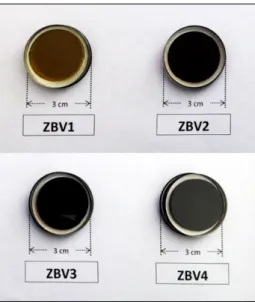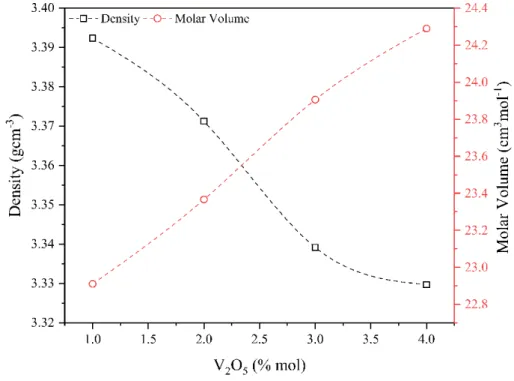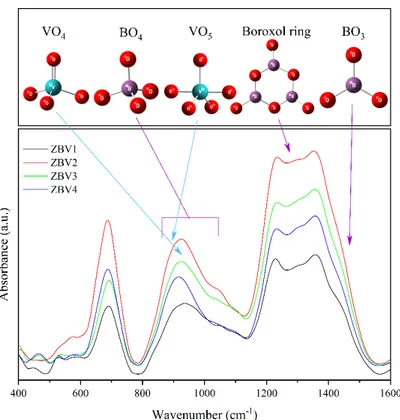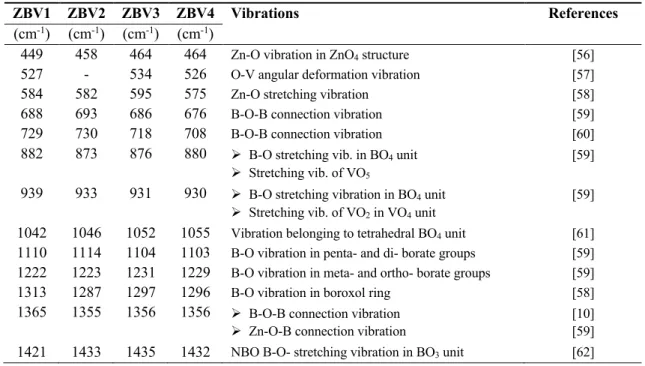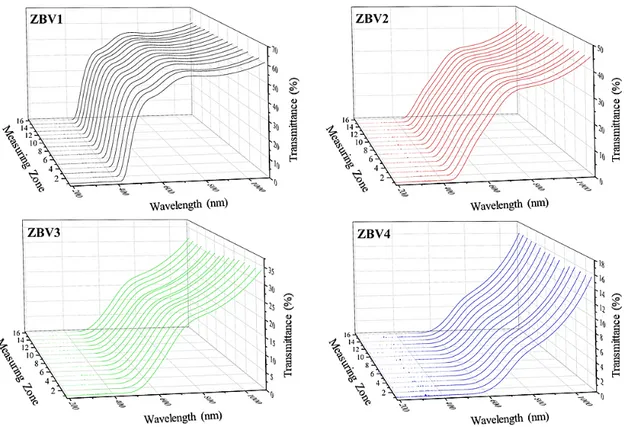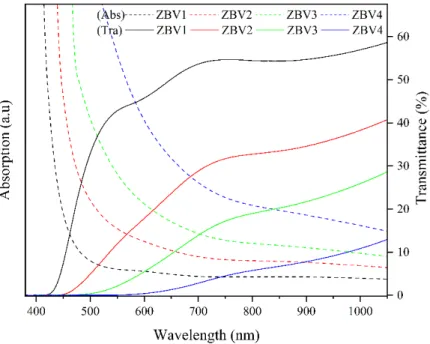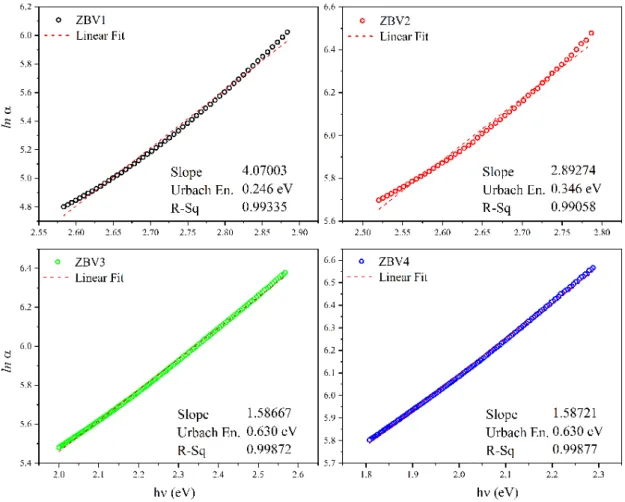* Corresponding Author DOI: 10.37094/adyujsci.678938
Synthesis and Optical, Thermal, Structural Investigation of Zinc-Borate Glasses
Containing V
2O
5Gökhan KILIÇ1,*
1Eskisehir Osmangazi University, Faculty of Science and Letters, Department of Physics, TR-26040
Eskisehir, Turkey
gkilic@ogu.edu.tr, ORCID: 0000-0002-6762-6898
Received: 22.01.2020 Accepted: 27.02.2020 Published: 25.06.2020
Abstract
Vanadium pentaoxide (V2O5) doped zinc borate (ZnB) oxide glasses that could be used in fiber optic cable cores in optoelectronics, in laser crystals in solar energy systems have been synthesized successfully. Structural characters of synthesized glasses were determined with differential scanning calorimeter (DSC) and Fourier-Transform infrared spectroscopy (FTIR). Glass transition (Tg), crystallization (Tc) and melting temperatures (Tm), and thermal stabilities (DT) of the glasses were determined and also their association with the change in V2O5 was explained. Structural units of boron and zinc that form the structure were determined according to FTIR data. As a result, it was determined that boron formed the glass matrix with BO3, BO4 and boroxol ring structural units; on the other hand, zinc contributed to the glass matrix with tetrahedral ZnO4 and octahedral ZnO6 structural units, and vanadium usually had modifier role in the structure with its VO4 and VO5 structural units. V2O5’s presence in the structure with increasing amount changes thermal, structural and physical properties. Among the properties that significantly change, the most important one is optical properties. Indirect optical band gaps, Urbach energies, refractive index values of these synthesized samples were determined, and quite clear shifts towards red region were observed in the transmittance and absorption spectra. Optical band gap decreased to 1.24 eV from 2.55 eV with increasing amount of V2O5; on the other hand,
Urbach energy was determined to increase to 0.630 eV from 0.246 eV. Densities, molar volumes of these synthesized glasses were also examined and commented on.
Keywords: ZnO; B2O3; V2O5; Zinc-Borate glass; FTIR.
V2O5 İçeren Çinko-Borat Camların Sentezi ve Optik, Termal, Yapısal İncelenmeleri
Öz
Optoelektronikte fiber optik kablo korlarında, laser kristallerinde ve güneş enerji sistemlerinde kullanılabilecek vanadium pentaoksit (V2O5) katkılı çinko borat (ZnB) oksit camlar başarıyla sentezlenmiştir. Sentezlenen camlara ait yapısal karakterler diferansiyel taramalı kalorimetre (DSC) ve Fourier dönüşümlü kızılötesi spektroskopisi (FTIR) ile belirlenmiştir. Camsı geçiş (Tg), kristallenme (Tc), erime sıcaklıkları (Tm) ve termal kararlılıklar (DT) belirlenerek V2O5 değişimiyle ilgisi açıklanmıştır. FTIR verilerine göre yapıyı oluşturan bor ve çinkonun yapısal birimleri belirlenmiştir. Borun cam matrisini BO3, BO4 ve boroksol halka yapısal birimleriyle oluşturduğu, çinkonun ise cam matrisine tetrahedral ZnO4 ve oktahedral ZnO6 yapısal birimleri ile katkıda bulunduğu, vanadyumun yapıda çoğunlukla VO4 ve VO5 yapısal birimleriyle yer alarak düzenleyici görev üstlendiği belirlenmiştir. V2O5 katkısının artması yapının termal, yapısal ve fiziksel özelliklerini değiştirmektedir. Belirgin biçimde değiştirdiği özelliklerin başında optik özellikler gelmektedir. Sentezlenen numunelere ait indirekt optik bant aralığı, Urbach enerjisi, kırılma indisi değerleri belirlenmiş, geçirgenlik ve absorpsiyon spektrumlarında kırmızı dalgaboyuna kaymalar net bir şekilde gözlenmiştir. Optik bant aralığı V2O5 artışıyla 2.55 eV dan 1.24 eV’a azalmış, buna karşılık Urbach enerjisi 0.246 eV’dan 0.630 eV’a arttığı belirlenmiştir. Ayrıca, sentezlenen numunelere ait yoğunluk, molar hacim incelenmiş ve yorumlanmıştır.
Anahtar Kelimeler: ZnO; B2O3; V2O5; Çinko-Borat cam; FTIR.
1. Introduction
Glass, an amorphous material, has an important place in respect to technology and science. Besides silicon dioxide (SiO2), phosphorus pentoxide (P2O5), boron oxide (B2O3), and vanadium pentoxide (V2O5) are being used in the synthesis of glasses the most. Among these, B2O3 is known to be the best glass former [1, 2]. Borate glasses in which B2O3 establishes the glass network are very important optical materials due to their low melting points, high transmittance properties and high thermal stabilities [3]. They are frequently being used in the making of dielectric materials and used as isolation materials. Though they are being used as dielectric materials, the inclusion
of transition metal ions in the borate glass network leads to the achievement of semiconductor character or these glasses. Transition metals are nowadays being extensively used in glass science due to their presence in two or more valance states that alters the structural and optical characters [4-10].
It is possible to find examination studies performed on binary zinc-borate structures among transition metal doped borate glasses and also ternary structures and structures having more components in the literature [11-22]. Except for glass systems, it is possible to find zinc-borate ceramic structures, as well [23].
Zinc-borate glasses are being used in plasma screens and panels for high quality and performance [24, 25]. Zinc-borate glasses are promising materials for a large field including television panels and computer monitors. They are preferred due to having high voltage resistance in providing rapid surge in dielectric layers and being highly transparent. Since zinc borate glasses that do not contain lead possess all the aforementioned qualities, they are shown to be appropriate materials for applications that are in question [26].
Studies on vanadium due to their interesting optical, electrical and magnetic properties have significantly increased recently. Though studies on transition metal doped glasses can be found in the literature frequently [27-37], there are still components, compositions and properties that have not yet been studied. Glasses containing vanadium, which is a transition metal, show semiconducting properties since they contain V4+, V5+ valance states [38-45]. Vanadium doped glasses are known to be n-type semiconductors for low V4+/V5+ ratio [46]. Glasses with vanadium content have a wide range of use from the production of solid-state devices to memory and optical switching, devices like electrical threshold, and in the formation of fiber optics [47, 48]. Therefore, they are materials with potential for most electronic and optoelectronic applications [49]. In the literature, some characteristics of glasses having different compositions as a result of combining zinc-borate glass systems with V2O5 have been elaborated [50, 51].
In this study, ZnO-B2O3-V2O5 glasses doped with V2O5 and containing high ratio of ZnO, so they can find a use in optoelectronics were synthesized successfully. Compared borate glasses that are sensitive to humidity, these synthesized glasses are resistant to air, water; therefore, they are considered to be important since boron is able to find use in respect to technological applications. Structural and thermal properties of these synthesized glasses were examined in a detailed way and discussed. Characterization of this structure considered to become a potential material that could be used in fiber cable cores in optoelectronics, in laser settings and, also in solar energy systems was revealed.
2. Materials and Methods 2.1. Sample preparation
ZnO-B2O3 glass samples containing V2O5 were synthesized from chemicals having 99.5% purity (Alfa Aesar) according to (100-x)(0.6ZnO-0.4B2O3). (x)(V2O5) (x = 1, 2, 3, 4) composition. The method that was used in the synthesis of the glasses was melt-quenching method. Chemicals were weighed on an analytical scale having accuracy of 0.00001g, and then weighed chemicals were mechanically mixed for approximately 10 min and made uniform.
Prepared powder mixture was left in a porcelain crucible for 60 minutes in a Nabertherm LHT 02/17 LB brand high temperature furnace that was previously heated to 1100 °C for reaction to take place. At the end of the process, molten glass samples were shaped cylindrically in a steel mold and annealed for 60 minutes at 400 °C.
Figure 1: Synthesized ZnO-B2O3-V2O5 glass samples
Glass samples synthesized by this way (Fig. 1) were sliced with a Metkon brand Micracut 152 model cutting device with diamond disc for optical measurements having a diameter of 2.5 cm and a thickness of 2 mm; both surfaces of the cut samples were polished with a Metkon brand Forcipol 102 model polishing device. Some of the samples were grounded with a Retsch RM200 brand grinder to study their thermal and structural properties.
2.2. Characterization
Densities of glasses were determined with the principle of Archimedes. Samples were first weighed in the air with a KERN brand ABT 100-5m model analytical scale having an accuracy of 0.00001g, and then weighed again in immersion fluid. Ultra-pure water was selected as
immersion fluid. By using the measurements taken in the air and in the immersion fluid, densities of the samples were calculated with the below equation [52]:
𝐷 = 𝑊!
𝑊!− 𝑊" . 𝜌# (1)
In this equation, 𝑊! is the weight of the sample in the air, 𝑊" is the weight of the sample in the fluid and 𝜌# is the density of immersion fluid (
r
o = 0.998272 g.cm-3) at 20 °C. Molar volumes (Vm) of glass samples were calculated with the following equation:𝑉$ = ∑ 𝑥%𝑀%
𝐷 (2)
Here, 𝑥% is the mole ratio of the i.th component, 𝑀% is the molecular weight.
Transmittance and absorption spectra of the glasses were determined with Analytik Jena SPECORD 210 UV-Vis Spectrophotometer with steps of 1 nm. In addition, in order to determine the uniformity of the sample, transmittance spectra were determined with scanning attachment of the device by using 1.5 cm piece of the surface. Absorption spectra were used to calculate optical band gaps and Urbach energies of the synthesized samples.
Refractive index due to optical band gap was calculated with the following empirical relation [53]:
(𝑛&− 1)
(𝑛&+ 2)= 1 − 2 𝐸'
20 (3)
𝑛, is the refractive index of the samples, 𝐸' is optical band gap.
In order to determine the structural properties, powdered forms of the samples were used and their FTIR spectra were obtained. FTIR analyses were performed at room temperature within the wavenumber range of 400-1400 cm-1 by using diamond ATR with a resolution of 4 cm-1. Origin 2018 program was used to determine hidden bands in the spectrum.
Netzsch STA 449F3 simultaneous thermogravimetric analyze device was used in the determination of thermal properties. DSC measurements were made with approximately 50 mg of powdered sample between the range of room temperature and 1000 °C with increments of 1 °C. Glass transition, crystallization and melting temperatures were calculated from the obtained
graphs with ONSET method (Fig. 3). In addition, thermal stabilities (∆𝑇) belonging to glasses were calculated with the following equation:
∆𝑇 = 𝑇(− 𝑇) (4)
Here 𝑇( is the first crystallization temperature, 𝑇) is glass transition temperature.
3. Results and Discussion 3.1. Density and molar volume
Sample densities and molar volume values calculated with the help of Eqn. (1) are given in Table 1. In addition, sample codes and ratio of components within the glass can also be seen. As you can see in Fig. 2, density values of the samples decreased regularly from 3.392 g.cm-3 to 3.329 g.cm-3 with increasing amount of V
2O5. On the other hand, molar volume values increased from 22.910 cm3.mol-1 to 24.289 cm3.mol-1 almost linearly. V
2O5’s being a more complex molecule led to volume increase, in addition, since masses of shifting vanadium and zinc were close to each other, it resulted in decrease in the molar volume. Similar impact can also be found in the literature [54].
Table 1: Sample codes, % compositions and calculated density and molar volume values of synthesized
samples
Sample Code
ZnO B2O3 V2O5 Density Molar volume
mol % mol % mol % g.cm-3 (±0.001) cm3.mol-1 (±0.005)
ZBV1 59.40 39.60 1.00 3.392 22.910
ZBV2 58.80 39.20 2.00 3.371 23.366
ZBV3 58.20 38.80 3.00 3.339 23.906
ZBV4 57.60 38.40 4.00 3.329 24.289
3.2. Thermal properties
DSC thermograms belonging to synthesized ZBV glass samples are given in Fig. 3, and their glass transition temperatures, crystallization and melting temperatures are given in Table 2. As it can be seen in DSC thermograms, curves belonging to 4 samples are almost identical in respect to their shapes. 3 ambiguous exothermic peaks in the shape of shoulders are followed by 1 endothermic peak. Glass transition temperatures can be seen within the range of 530-550 °C and glass transition temperature has decreased with increasing amount of V2O5. First crystallization temperature was around 740 °C; the range of 818-833 °C was the region of second crystallization temperature. When we have reviewed the literature, we can see that various crystalline phases are mentioned between glassy transition temperature and melting temperature in similar systems [55]. These are Zn3B2O6 crystalline phase around 680 °C and Zn3V2O8 crystalline phase around 700 °C. In Nb2O5 doped zinc-borate glasses, ZnNb2O6 crystalline phase containing Nb is found around 740 °C.
In the light of all these data, we estimate that the peak that we have observed in the proximity of 740 °C belong to Zn3V2O8 and ZnV2O6 crystalline phases in the glasses that we have synthesized. The second crystallization temperature decreased with increasing amount of V2O5. Melting temperatures belonging to were almost the same and around 935 °C. Decrease in glass transition temperatures and crystallization temperatures remaining almost the same with increasing amount of V2O5 naturally resulted in increase in the thermal stability (DT). Glassy transition temperatures are reported to increase in tellurium and silicon-based glasses with the addition of Nb2O5, V2O5 in increasing amounts. Decrease in glass transition temperatures of the samples in this study with increasing concentration of V2O5 can be explained with bond enthalpy. While B-O bond enthalpy was 809 kJmol-1, V-O bond enthalpy was lower (637 kJmol-1). Substituting O-B-O bonds with weaker O-V-O connections lowers activation energy for structural reorganizations. Accordingly, glass transition temperature decreases with increasing V2O5. Table 2: Glass transition, crystallization, melting temperatures and thermal stabilities of synthesized ZBV
glasses Sample Tg Tc1 Tc2 Tm DT Code (oC)( ±1) (oC)( ±1) (oC)( ±1) (oC)( ±1) (oC)( ±1.2) ZBV1 553 743 833 935 190 ZBV2 547 730 831 933 183 ZBV3 541 743 820 935 202 ZBV4 531 743 818 935 212 3.3. Structural examination
FTIR spectra are given all together in Fig. 4. In addition, basic structural units of boron and vanadium and their corresponding localizations in our synthesized glasses are also given within this figure. In Fig. 5, deconvolutions of FTIR spectra belonging to samples are given. FTIR spectra were examined in three basic regions.
The first region is the 400-800 cm-1 region. In this region, vibrations belonging to various connections can be seen. The second region is between 800-1200 cm-1 and mostly vibrations belonging to BO4 structural units of boron are observed in this region. The third region is the region around 1200-1500 cm-1 and mostly various vibrations corresponding to BO
3 structural unit of boron can be seen in these regions. Except for boron that forms the glass network, vibrations corresponding to various states of zinc and vanadium found in the glass can also be observed within these regions (Table 3).
Figure 4: 400-1600 cm-1 region FTIR spectra and localizations of structural units belonging to ZBV samples
One or more intensive peaks can be seen in all regions. Bands found between 449-464 cm -1 within the first regions are known to belong to the vibrations in the ZnO
4 unit. Apart from this, O-V angular vibration is reported to correspond to 526-534 cm-1, Zn-O stretching vibration correspond to 575-595 cm-1, and B-O-B connection vibration correspond to the bands within 676-730 cm-1. The most intense peak in this region belongs to the band around 680 cm-1 and shows the abundance of B-O-B connections within the structure.
Bands belonging to B-O stretching vibrations belonging to BO4 unit in the second region are found within the ranges of 873-886 cm-1, 930-939 cm-1, 1042-1055 cm-1. It is also known in V2O5 containing structures that the presence of bands belonging to the vibrations of VO5 and VO4 structural units are also found within the regions of 873-886 cm-1 and 930-939 cm-1 where B-O stretching vibrations have been encountered. Intensity of bands belonging to B-O vibration is known to decrease with increasing concentration of V2O5 in penta- and diborate groups within the range of 1103-1114 cm-1; however, the intensity of the band belonging to B-O vibration in meta- and orthoborate groups increases within the range of 1222-1231 cm-1 found in the third region.
Figure 5: Deconvolution of FTIR spectra belonging to ZBV samples. Straight lines show the FTIR spectra
belonging to samples and dashed lines show the Gaussian bands obtained from deconvolution
Table 3: Bands belonging to ZBV samples and corresponding vibrations
ZBV1 ZBV2 ZBV3 ZBV4 Vibrations References
(cm-1) (cm-1) (cm-1) (cm-1)
449 458 464 464 Zn-O vibration in ZnO4 structure [56] 527 - 534 526 O-V angular deformation vibration [57]
584 582 595 575 Zn-O stretching vibration [58]
688 693 686 676 B-O-B connection vibration [59]
729 730 718 708 B-O-B connection vibration [60]
882 873 876 880 Ø B-O stretching vib. in BO4 unit Ø Stretching vib. of VO5
[59]
939 933 931 930 Ø B-O stretching vibration in BO4 unit Ø Stretching vib. of VO2 in VO4 unit
[59] 1042 1046 1052 1055 Vibration belonging to tetrahedral BO4 unit [61] 1110 1114 1104 1103 B-O vibration in penta- and di- borate groups [59] 1222 1223 1231 1229 B-O vibration in meta- and ortho- borate groups [59] 1313 1287 1297 1296 B-O vibration in boroxol ring [58] 1365 1355 1356 1356 Ø B-O-B connection vibration
Ø Zn-O-B connection vibration
[10] [59] 1421 1433 1435 1432 NBO B-O- stretching vibration in BO3 unit [62]
In the third region, it was observed that bands belonging to boroxol ring and BO3 structure of boron was prominently found; nevertheless, bands belonging to B-O-B and Zn-O-B vibrations
were also present. Bands within the range of 1287-1365 cm-1 belong to B-O in the boroxol ring, bands in the 1421-1435 cm-1 regions belong to B-O- vibrations found in the BO
3 unit having non-bridging oxygen (NBO). Although the band around 1355 cm-1 is known to belong to B-O-B connection vibration, it was reported in some studies that it corresponded to Zn-B-O connection vibration in similar structures.
3.4. Optical properties
Transmittance spectra obtained with scanning 1.5 cm piece of the surface belonging to the synthesized glassed are given in Fig. 6 and transmittance and absorption spectra obtained from a single point of the samples are given in Fig. 7. Transmittance spectra obtained from surface scanning spectrophotometer were obtained from 16 different regions with intervals of 1 mm each. When compared with the transmittance curves found in these spectra, which were used to determine the uniformity of the samples, transmittance was seen to be similar in spectrum of every sample. This proves that a significant aggregation or bubble was not present and the samples had uniform distribution.
Figure 6: Transmittance spectra obtained by scanning approximately 1.5 cm regions of the samples
In Fig. 7, in which data obtained from a single point were evaluated collectively, absorption edges of spectra belonging to transmittance and absorption were observed to shift towards red (long wavelength) with increasing concentration of V2O5. Spectra shifted towards long
wavelength for approximately for 25 nm each. Transmittance value decreased significantly. Switching oxygen bond in the glass network and change in the number of non-bridging oxygen (NBO) in the network also changes absorption properties [54]. Shifting of the absorption edge towards long wavelength with increasing amount of V2O5 and also decrease in optical band gaps might be explained with this change.
Figure 7: Absorption-transmittance spectra of ZBV samples against wavelength
Optical band gaps of synthesized glass samples were calculated by using absorption spectrum for indirect transitions. Absorption coefficient is given according to Lambert – Beer – Bouguer Law [63].
𝛼 = 0.202 8𝐴𝑑; (5)
Here, A is the absorbance, d is the thickness of the sample. Photon energies belonging to wavelengths corresponding to linear part of the absorption spectrum were calculated with the help of the following equation [63]:
𝐸 = ℎ𝜐 (6)
Moreover, (𝛼ℎ𝜐)* &⁄ ~ℎ𝜐 graphics were plotted for indirect transitions for each sample. In these equations, 𝛼 is the absorption coefficient, h is the Planck constant, υ is photon frequency and in addition, hυ is the photon energy.
From the value of this line passing through the linear part of this plotted Tauc curve (Fig. 8) corresponding to (𝛼ℎ𝜐)* &⁄ = 0 optical band gap belonging to the sample is found. Optical band gaps of V2O5 doped glasses varied between 2.55 eV and 1.24 eV. Increase in V2O5 regularly reduced the optical band gap.
Figure 8: Tauc Plots belonging to ZBV samples
With the curve of the absorption edge in the semi-logarithmic plot (Fig. 9),
Δ𝐸 = @𝑑(𝑙𝑛𝛼) 𝑑(ℎ𝜈)C
,*
(7) Urbach Energies were calculated [63]. Fitting values of lines plotted from the straight part of the absorption edge were R2 > 0.99. Here,
D
E is named as Urbach energy, α is absorption coefficient and hυ as photon energy.A stable increase was observed in Urbach energies due to increase in V2O5 concentration. Urbach energy was calculated between the range of 0.246 eV and 0.630 eV. Urbach energy belonging to non-doped, pure 60% ZnO-40% B2O3 glass was calculated within the range of 0.17 eV [54]. This result is in line with the values that have been obtained in this study. Low Urbach energy value shows us that the structure of the synthesize glass structure is uniform and stable. Increase in V2O5 concentration in the glass network shows that the structure has become irregular and unstable [64].
Table 4: Optical band gap, Urbach energies and refractive indices of synthesized ZBV glasses Sample
Code
Optical band gap Urbach energies Refractive index
(eV) (eV)
ZBV1 2.55 0.246 2.530
ZBV2 2.25 0.346 2.635
ZBV3 1.63 0.630 2.917
ZBV4 1.24 0.630 3.170
Refractive index is an important data for materials that are considered to be used in optoelectronics. Refractive indices were determined with the help of Eqn. (3) using optical band gaps data within the region corresponding to the absorption edge. Refractive indices of the samples were calculated within the range of 2.530-3.170. As it can be seen in Table 4, refractive index increased in direct proportion to increase in V2O5.
Figure 9: Urbach Energies, slopes, and R2 fitting values of ZBV samples
4. Conclusions
Ternary zinc borate oxide glass samples doped with different ratios of V2O5 were synthesized successfully. Physical, structural, thermal, and optical characterization of these
synthesized samples were performed. Structural units were determined with FTIR. B2O3 was found to be present in the glass network in the structure of the boroxol ring, planar BO3, tetrahedral BO4. ZnO, acting as the organizer with its low concentration in the structures in which it is found, was determined to be present in the samples of this study in tetrahedral ZnO4 and octahedral ZnO6 structural units; and it was concluded that it might be present in the glass network as a glass former. Vanadium is present in the glass network with VO4 and VO5 structural unit. Increase in VO5 shifted the absorption edge significantly towards the red region and correspondingly decrease optical band gap to 1.24 eV from 2.55 eV and as expected, led to increase in Urbach energy. Increase in Urbach energy proves that V2O5 renders the structure nonuniform and unstable. As a result of thermal characterization, V2O5 increase was found to decrease glass transition temperature to 531 °C from 553 °C. While density decreased with increasing amount of V2O5, molar volume values demonstrated increase, as well. Similar to molar volume, refractive index also increased. High refractive indices increasing to 3.170 from 2.530 showed that synthesized glasses are potential materials that could be used in optical system requiring high refractive index. These glasses, considered to find application in many fields of optoelectronics also have the property of being novel materials for solar energy systems due to their semiconducting properties.
References
[1] Kılıç, G., Değişik bileşimli camların hazırlanması, fiziksel ve optik özelliklerinin
incelenmesi. PhD Thesis, Eskişehir Osmangazi University, Eskişehir, Turkey, 2006.
[2] Rao, R.B., Veeraiah, N., Study on some physical properties of Li2O-MO-B2O3: V2O5
glasses, Physica B: Condensed Matter, 348, 256-271, 2004.
[3] El-Batal, H.A.R., Ezz-El-Din, F.M., Interaction of γ-rays with Some Alkali Alkaline
Earth Borate Glasses Containing Chromium, Journal of the American Ceramic Society, 76, 523,
1993.
[4] Abdel-Baki, M., El-Diasty, F., Role of oxygen on the optical properties of borate glass
doped with ZnO, Journal of Solid State Chemistry, 184, 2762-2769, 2011.
[5] El-Falaky, G.E., Gaafar, M.S., Abd El-Aal, N.S., Ultrasonic relaxation in Zinc-Borate
glasses, Current Applied Physics, 12, 589-596, 2012.
[6] Sumalatha, B., Omkaram, I., Rao, T.R., Raju, Ch. L., Alkaline earth zinc borate glasses
doped with Cu2+ ions studied by EPR, optical and IR techniques, Journal of Non-Crystalline Solids, 357, 3143-3152, 2011.
[7] Kumar, R.R., Bhatnagar, A.K., Rao, J.L., EPR of vanadyl ions in alkali lead borate
glasses, Materials Letters, 57, 178-182, 2002.
[8] Rada, M., Rada, S., Pascuta, P., Culea, E., Structural properties of
[9] Rao, T.R., Reddy, Ch.V., Krishna, Ch.R., Thampy, U.S.U., Raju, R.R., Rao, S., Ravikumar, R.V.S.S.N., Correlation between physical and structural properties of Co2+ doped
mixed alkali zinc borate glasses, Journal of Non-Crystalline Solids, 357, 3373-3380, 2011.
[10] Singh, G.P., Kaur, S., Kaur, P., Kumar, S., Singh, D.P., Structural and optical
properties of WO3-ZnO-PbO-B2O3 glasses, Physica B: Condensed Matter, 406, 1890-1893, 2011. [11] He, F., Wang, J., Deng, D., Effect of Bi2O3 on structure and wetting studies of Bi2O3
-ZnO-B2O3 glasses, Journal of Alloys and Compounds, 509, 6332-6336, 2011.
[12] Lian, Z., Wang, J., Lv, Y., Wang, S., The reduction of Eu3+ to Eu2+ in air and
luminescence properties of Eu2+ activated ZnO-B
2O3-P2O5 glasses, Journal of Alloys and Compounds, 430, 257-261, 2007.
[13] Saritha, D., Markandeya, Y., Salagram, M., Vithal, M., Effect of Bi2O3 on physical,
optical and structural studies of ZnO-Bi2O3-B2O3 glasses, Journal of Non-Crystalline Solids, 354, 5573-5579, 2008.
[14] Li, S., Chen, P., Li, Y., Structural and physical properties in the system ZnO-B2O3
-P2O5-RnOm, Physica B: Condensed Matter, 405, 4845-4850, 2010.
[15] Aleksandrov, L., Komatsu, Iordanova, R., Dimitriev, Y., Structure study of MoO3
-ZnO-B2O3 glasses by Raman spectroscopy and formation of ZnMoO4 nanocrystals, Optical Materials, 33, 839-845, 2011.
[16] Lakshminarayana, G., Buddhudu, S., Spectral analysis of Sm3+ and Dy3+: B
2O3
-ZnO-PbO glasses, Physica B: Condensed Matter, 373, 100-106, 2006.
[17] Singh, H., Singh, K., Gerward, L., Singh, K., ZnO-PbO-B2O3 glasses as gamma-ray
shielding materials, Nuclear Instruments and Methods in Physics Research B, 207, 257-262,
2003.
[18] Thulasiramudu, A., Buddhudu, S., Optical characterization of Sm3+ and Dy3+:
ZnO-PbO- B2O3 glasses, Spectrochimica Acta A, 67, 802-807, 2007.
[19] Mosner, P., Vosejpkova, K., Koudelka, L., Montagne, L., Revel, B., Structure and
properties of ZnO-B2O3-P2O5-TeO2 glasses, Materials Chemistry and Physics, 124, 732-737, 2010.
[20] Wu, J., Xie, C., Hu, J., Zeng, D., Wang, A., Microstructure and electrical
characteristics of ZnO-B2O3-PbO-V2O5-MnO2 ceramics prepared from ZnO nanopowders, Journal of the European Ceramic Society, 24, 3635-3641, 2004.
[21] Bale, S., Rahman. S., Electrical conductivity studies of Bi2O3-Li2O-ZnO-B2O3 glasses, Materials Research Bulletin, 47, 1153-1157, 2012.
[22] Ji, L.N., Li, J.B., Liang, J.K., Sun, B.J., Liu, Y.H., Phase relations and flux research
for ZnO crystal growth in the ZnO-B2O3-P2O5 system, Journal of Alloys and Compounds, 459, 481-486, 2008.
[23] Hu, Y., Wei, D., Fu, Q., Zhao, J., Zhou, D., Preparation and microwave dielectric
properties of 3ZnO·B2O3 ceramics with low sintering temperature, Journal of the European Ceramic Society, 32, 521-524, 2012.
[24] Raju, G.N., Reddy, M.S., Sudhakar, K.S.V., Spectroscopic properties of copper ions
in ZnO-ZnF2-B2O3 glasses, Optical Materials, 29, 1467-1474, 2007.
[25] Kim, D.N., Lee, J.Y., Huh, J.S., Thermal and electrical properties of BaO-B2O3-ZnO
glasses, Journal of Non-Crystalline Solids, 306, 70-75, 2002.
[26] Masuda, H., Kimura, R., Sakamoto, N., Properties and Structure of Glasses in the
[27] Kundu, V., Dhiman, R.L., Goyal, D.R., Maan, A.S., Physical and electrical properties
of semiconducting Fe2O3-V2O5-B2O3 glasses, Journal of Optoelectronics and Advanced Materials, 2(7), 428-432, 2008.
[28] Saritha, D., Markandeya, Y., Salagram, M., Vithal, M., Effect of Bi2O3 on physical,
optical and structural studies of ZnO-Bi2O3-B2O3 glasses, Journal of Non-Crystalline Solids, 354, 5573-5579, 2008.
[29] Toderaş, M., Filip, S., Ardelean, I., Structural study of the Fe2O3-B2O3-BaO glass
system by FTIR spectroscopy, Journal of Optoelectronics and Advanced Materials, 3(8),
1121-1123, 2006.
[30] Schwarz, J., Ticha, H., Some optical properties of BaO-PbO-B2O3 glasses, Journal of Optoelectronics and Advanced Materials, 5(1), 69-74, 2003.
[31] Nagaraja, N., Sankarappa, T., Kumar, M.P., Electrical conductivity studies in single
and mixed alkali doped cobalt–borate glasses, Journal of Non-Crystalline Solids, 354,
1503-1508, 2008.
[32] Chaudhry, M.A., Altaf, M., Optical absorption studies of sodium cadmium phosphate
glasses, Materials Letters, 34, 213-216, 1998.
[33] Al-Hajry, A., Al-Shahran, A., El-Desoky, M.M., Structural and other physical
properties of barium vanadate glasses, Materials Chemistry and Physics, 95, 300-306, 2006.
[34] Sharma, B.I., Robi, P.S., Srinivasan, A., Microhardness of ternary vanadium
pentoxide glasses, Materials Letters, 57, 3504-3507, 2003.
[35] Ghosh, A., Bhattacharya, S., Ghosh, A., Optical and other structural properties of
some zinc vanadate semiconducting glasses, Journal of Alloys and Compounds, 490, 480-483,
2010.
[36] Tawaki, D.M., Adlan, M.J.B., Abdullah, M.J., DC electrical conductivity of
semiconducting cobalt–phosphate glasses, Journal of Non-Crystalline Solids, 357, 2152-2155,
2011.
[37] Mandal, S., Ghosh, A., Electrical properties of lead vanadate glasses, Physical Review B: Condensed Matter and Materials Physics, 49, 3131, 1994.
[38] Rao, R.B., Veeraiah, N., Study on some physical properties of Li2O-MO-B2O3: V2O5
glasses, Physica B: Condensed Matter, 348, 256-271, 2004.
[39] Mott, N.F., Conduction in glasses containing transition metal ions, Journal of Non-Crystalline Solids, 1, 1-17, 1968.
[40] Austin, G., Mott, N.F., Polarons in crystalline and non-crystalline materials, Advances in Physics, 18, 41-102, 1969.
[41] Sen, S., Ghosh, A., Structure and other physical properties of magnesium vanadate
glasses, Journal of Non-Crystalline Solids, 258, 29-33, 1999.
[42] Moustafa, Y.M., El-Damrawi, G., Meikhail, M.S., Effect of Vanadium oxide on the
structure and properties of lithium borate glasses, Mans Science Bulletin C, 20, 71, 1993.
[43] El-Damrawi, G., Moustafa, Y.M., Meikhail, M.S., Phase separation and NMR studies
on sodium boro-silicate glasses containing V2O5, Mans Science Bulletin C, 20, 83, 1993. [44] Singh, K., Ratnam, J.S., Electrical conductivity of the Li2O-B2O3 system with V2O5, Solid State Ionics, 31, 221-226, 1988.
[45] Mekki, A., Khattak, G.D., Holland, D., Chinkhota, M., Wenger, L.E., Structure and
magnetic properties of vanadium–sodium silicate glasses, Journal of Non-Crystalline Solids, 318,
193-201, 2003.
[46] Ebendorff-Heidepriem, H., Riziotis, C., Taylor, E.R., Novel photosensitive glasses, Glass Science and Technology, 75, 54, 2002.
[47] Ghosh, A., Transport properties of vanadium germanate glassy semiconductors, Physical Review B: Condensed Matter and Materials Physics, 42, 5665, 1990.
[48] Sudarsan, V., Kulshreshtha, S.K., Study of structural aspects of V2O5–P2O5–B2O3
glasses, Journal of Non-Crystalline Solids, 258, 20-28, 1999.
[49] Ezz-Eldin, F.M., Radiation effects on some physical and thermal properties of V2O5–
P2O5 glasses, Nuclear Instruments and Methods in Physics Research B, 159, 166-175, 1999. [50] Sindhu, S., Sanghi, S., Agarwal, A., Kishore, N., Seth, V.P., Effect of V2O5 on structure
and electrical properties of zinc borate glasses, Journal of Alloys and Compounds, 428, 206-213,
2007.
[51] Li, H., Lin, H., Chen, W., Luo, L., IR and Raman investigation on the structure of
(100-x)[0.33B2O3–0.67ZnO]–xV2O5 glasses, Journal of Non-Crystalline Solids, 352, 3069-3073, 2006.
[52] Elkhoshkhany, N., El-Mallawany, R., Syala, E., Mechanical and thermal properties
of TeO2–Bi2O3–V2O5–Na2O–TiO2 glass system, Ceramics International, 42(16), 19218–19224, 2016.
[53] Dimitrov, V., Sakka, S., Linear and nonlinear optical properties of simple oxides. II, Journal of Applied Physics, 79, 1741-1745, 1996.
[54] Altaf, M., Chaudhry, M.A., Zahid, M., Study of optical band gap of zinc-borate
glasses, Journal of Research (Science), 14(2), 253-259, 2003.
[55] Kaur, A., Khanna, A., Sathe, V.G., Gonzalez, F., Ortiz, B., Optical, thermal, and
structural properties of Nb2O5-TeO2 and WO3-TeO2 glasses, Phase Transitions, 86(6), 598-619, 2013.
[56] Mohamed, N.B., Yahya, A.K., Deni, M.S.M., Mohamed, S.N., Halimah, M.K., Sidek, H.A.A., Effects of concurrent TeO2 reduction and ZnO addition on elastic and structural
properties of (90−x)TeO2–10Nb2O5–(x)ZnO glass, Journal of Non-Crystalline Solids, 356, 1626– 1630, 2010.
[57] Laila, S., Supardan, S.N., Yahya, A.K., Effect of ZnO addition and concurrent
reduction of V2O5 on network formation and elastic properties of lead vanadate (55−x)V2O5–
45PbO–(x)ZnO glass system, Journal of Non-Crystalline Solids, 367, 14–22, 2013.
[58] Pascuta, P., Vladescu, A., Borodi, G., Culea, E., Tetean, R., Structural and magnetic
properties of zinc ferrite incorporated in amorphous matrix, Ceramics International, 37, 3343–
3349, 2011.
[59] Arora, S., Kundu, V., Goyal, D.R., Maan, A.S., Effect of stepwise replacement of LiF
by ZnO on structural and optical properties of LiF. B2O3 glasses, Turkish Journal of Physics, 37, 229–236, 2013.
[60] Agarwal, A., Sheoran, A., Sanghi, S., Bhatnagar, V., Gupta, S.K., Arora, M.,
Structural investigation and electron paramagnetic resonance of vanadyl doped alkali niobium borate glasses, Spectrochimica Acta A, 75, 964–969, 2010.
[61] Jiao, Q., Yu, X., Xu, X., Zhou, D., Qiu, J., Relationship between Eu3+ reduction and
glass polymeric structure in Al2O3-modified borate glasses under air atmosphere, Journal of Solid State Chemistry, 202, 65–69, 2013.
[62] Razali, W.A.W., Azman, K., Hashim, S., Alajerami, Y.S.M., Syamsyir, S.A., Mardhiah, A., Ridzwan, M.H.J., Physical, Structural, and Luminescence Studies of Nd3+ Doped
MgO–ZnO Borate Glass, Optics and Spectroscopy, 115, 701–707, 2013.
[63] Kilic, G., Issever, U.G., Ilik, E., Characterization of Er3+ doped ZnTeTa
semiconducting oxide glass, Journal of Materials Science: Materials in Electronics, 30(9),
8920-8930, 2019.
[64] Issever, U.G., Kilic, G., Peker, M., Ünaldi, T., Aybek, A.S., Effect of low ratio V5+
doping on structural and optical properties of borotellurite semiconducting oxide glasses, Journal
